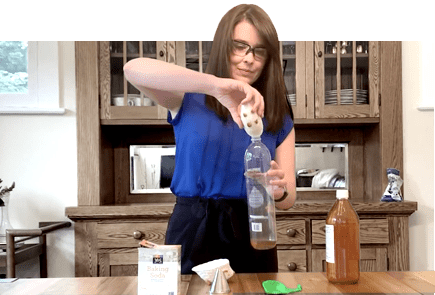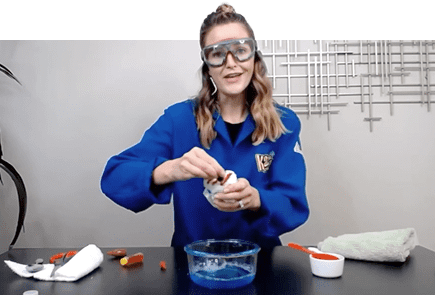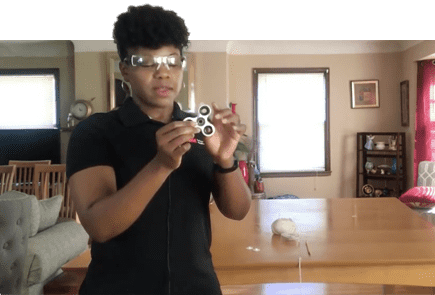Watch up-close to see how catalysts help ignite chemical reactions. Join Camille Schrier, a scientist who was crowned Miss America 2020, as she shows you how to make a chemical reaction so big it’s fit for elephants!
Background
The elephant toothpaste experiment is so dramatic because the reaction happens quickly. Hydrogen peroxide breaks down naturally over time, especially when exposed to light, but in this reaction the yeast causes that breakdown to happen much quicker. This is because yeast is a catalyst - a substance that can help the reactants react to each other faster, without becoming part of the end products of the reaction. Catalysts were first written about in 1794 by a Scottish chemist named Elizabeth Fulhame. She was writing about chemical reactions used in dyes and paints, and described lots of different ways that metals and other materials interact. Since then, chemists and engineers have discovered lots of other ways to use catalysts, and they help make many materials that we use today. Yeast is a naturally occurring catalyst that is good at breaking down hydrogen peroxide (H2O2) into water (H2O) and oxygen (O2). In this experiment, we will see how that process looks when it happens quickly.
Key Concepts
- Molecular Interaction
- Energy Conservation
Materials
- An adult helper
- Safety glasses
- ½ cup hydrogen peroxide
- 1 packet of dry yeast (or 1 tablespoon)
- Dish soap
- Plastic water bottle
- Baking pan or tray (to contain the mess)
- Food coloring (optional)
Preparation
- Put the yeast in a small cup or bowl, and add about 3 tablespoons of warm water to activate it.
- Put your safety glasses on. Mix the hydrogen peroxide and a few squirts of dish soap in the plastic water bottle. Add food coloring to this if you like.
- Place the plastic water bottle on the baking pan or tray, and make sure you are in an area that is easy to clean up- bathroom, kitchen or outside are all good options.
- Make a prediction about what is going to happen when you add the yeast to the hydrogen peroxide and soap mixture.
- Carefully pour the yeast mixture into the bottle and stand back- watch what happens as the yeast and hydrogen peroxide mix.
- Be sure to clean up when you are done. Your mixture can be dumped down the sink, and all of the containers and measuring tools you used can be washed and put away. Make sure to clean up any mess that was left on the ground or floor as well.
Observation and Results
You should see the mixture start to foam and shoot out the top of the plastic bottle. This is happening because the hydrogen peroxide is breaking down into water and oxygen very quickly due to the yeast. The yeast is acting as a catalyst to speed up the reaction. The oxygen gas takes up a lot more space than when it was in liquid form, so it starts to leave the bottle. The foam is caused by the dish soap forming bubbles with the oxygen as it is produced.
You may have also noticed some steam coming off of the foam, or that it feels warm to the touch. That is because this reaction is exothermic - it releases heat as a form of energy. It takes more energy to hold the molecules together in the form of hydrogen peroxide than it does to hold the oxygen and water molecules together, so when the peroxide molecules break up, that extra energy has to go somewhere. It gets released as heat.
What would happen if you tried the reaction without soap? What do you think you would see? Does changing the container you do the reaction in change the way the foam moves? Can you think of any other exothermic reactions? Why would it be useful to have a reaction that can produce heat? Can you think of other chemical reactions that mix liquids to produce gas? Are those similar or different to this reaction? Why do you think yeast naturally breaks down hydrogen peroxide? There are lots of ways to find out more about this reaction. Do some research on your own and see what other people have done with it.
Safety First and Adult Supervision
- Follow the experiment’s instructions carefully.
- A responsible adult should assist with each experiment.
- While science experiments at home are exciting ways to learn about science hands-on, please note that some may require participants to take extra safety precautions and/or make a mess.
- Adults should handle or assist with potentially harmful materials or sharp objects.
- Adult should review each experiment and determine what the appropriate age is for the student’s participation in each activity before conducting any experiment.
Next Generation Science Standard (NGSS) Supported - Disciplinary Core Ideas
This experiment was selected for Science at Home because it teaches NGSS Disciplinary Core Ideas, which have broad importance within or across multiple science or engineering disciplines.
Learn more about how this experiment is based in NGSS Disciplinary Core Ideas.
Engineering Design (ETS)1: Engineering Design
Grades K-2
- 2-PS1-1. Different kinds of matter exist and many of them can be either solid or liquid depending on temperature. Matter can be described and classified by its observable properties.\n2-PS1-2. Different properties are suited to different purposes.
Grades 3-5
- 5-PS1-1. Matter of any type can be subdivided into particles that are too small to see, but even then, the matter still exists and can be detected by other means.
- 5-PS1-2. The amount (weight) of matter is conserved when it changes form, even in transitions in which it seems to vanish.
- 5-PS1-3. Measurements of a variety of properties can be used to identify materials.
Grades 6-8
- MS-PS1-1.
- Substances are made from different types of atoms, which combine with one another in various ways.
- Atoms form molecules that range in size from two to thousands of atoms.
- MS-PS1-2,3.
- Each pure substance has characteristic physical and chemical properties that can be used to identify it.
- MS-PS1-4.
- Gases and liquids are made of molecules or inert atoms that are moving about relative to each other.\nIn a liquid, the molecules are constantly in contact with others.
Grades 9-12
- HS-PS1-1. Each atom has a charged substructure consisting of a nucleus, which is made of protons and neutrons, surrounded by electrons.
- HS-PS1-2. The periodic table orders elements horizontally by the number of protons in the atom’s nucleus and places those with similar chemical properties in columns. The repeating patterns of this table reflect patterns of outer electron states.
- HS-PS1-3. The structure and interactions of matter at the bulk scale are determined by electrical forces within and between atoms.
- HS-PS1-4. Stable forms of matter are those in which the electric and magnetic field energy is minimized. A stable molecule has less energy than the same set of atoms separated; one must provide at least this energy in order to take the molecule apart
Grades K-2
- 2-PS1-4. Heating or cooling a substance may cause changes that can be observed. Sometimes these changes are reversible, and sometimes they are not.
Grades 3-5
- 5-PS1-4. When two or more different substances are mixed. A new substance with different properties may be formed.
- 5-PS1-2. No matter what reaction or change in properties occurs, the total weight of the substances does not change.\nGrades 6-8\nMS-PS1-2. Substances react chemically in characteristic ways.
- MS-PS1-3. In a chemical process, the atoms that make up the original substances are regrouped into different molecules, and these new substances have different properties from those of the reactants.
- MS-PS1-5. The total number of each type of atom is conserved, and thus the mass does not change.
- MS-PS1-6. Some chemical reactions release energy, others store energy.
Grades 9-12
- HS-PS1-4,5. Chemical processes, their rates, and whether or not energy is stored or released can be understood in terms of the collisions of molecules and the rearrangement of atoms into new molecules with consequent changes in the sum of all bond energies in the set of molecules that are matched by the changes in kinetic energy.
- HS-PS1-6. In many situations, a dynamic and condition-dependent balance between a reaction and the reverse reaction determines the numbers of all types of molecules present.
- HS-PS1-7. The fact that atoms are conserved, together with the knowledge of the chemical properties of the elements involved, can be used to describe and predict chemical reactions.
Explore Additional Science at Home Videos and Activities

C02 Balloon
Baking soda and acid reactions in baking make things puff and rise.
But how could you use this same chemical reaction to blow up a balloon?

Rainbow Bubble Snake
Everyone loves bubbles, but have you ever thought about how they form?
In this video, special guest, Kate the Chemist, shows you the science behind bubbles. With just a few simple materials, you’ll learn how to make a bright and colorful bubble snake using your breath, soap, water and a plastic water bottle.

Fidget Spinner
Your teacher might not love when you have one in class, but the physics behind fidget spinners are truly head-spinning!
Join 3M scientist Tesha R.-Alston Dampier as she shows you how a spinning motion changes the way things move.

